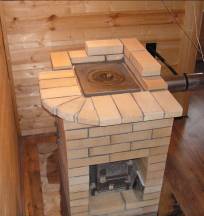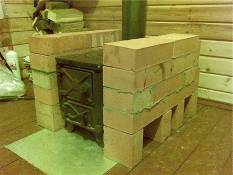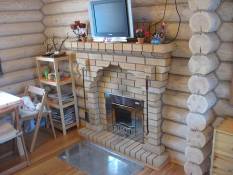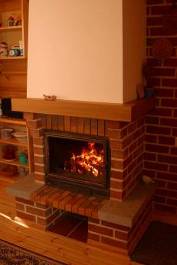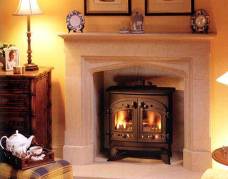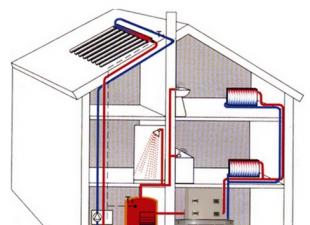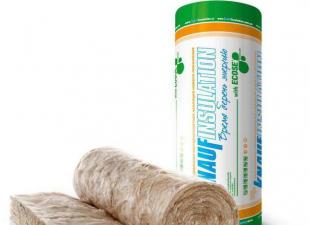In a small private house, in the country, in the bath, there is usually not enough space for a large brick oven. A small metal stove is installed there. The peculiarity of this material is that it quickly heats up, it also quickly loses heat. Brick lining a metal furnace increases the heating time several times. Making a brick casing is quite simple, it is quite possible to do it yourself.
Why cover is needed
Invented more than a hundred years ago, the potbelly stove is still popular today due to its positive properties:
- Light weight;
- Long service life;
- Compactness;
- Mobility;
- Fast space heating;
- Ease of installation.
She has few disadvantages:
- Poorly retains heat;
- The surface becomes very hot during firing.
To eliminate these phenomena, brick walls are laid around the metal structure.
As a result, the oven receives new positive properties:
- A metal furnace during the combustion of fuel quickly heats up and gives off heat. As soon as the fire goes out, the stove cools down quickly and the temperature in the room drops. The bricks surrounding the surface of the kiln heat up and, unlike metal, release heat energy slowly. Brick lining the stove maintains a comfortable temperature in the room longer.
- During the combustion of fuel, the metal heats up so much that touching it can cause a burn. The surface of the brick does not heat up to such a high temperature. The heat from the heater becomes softer and more evenly distributed throughout the room.
- Brick gives the oven an attractive look. Due to its qualities, it can turn a simple stove into a decorative element that adorns the interior.
- The brick shell "breathes". In the process of heating, moisture from the brick evaporates into the room, and is absorbed during cooling. As a result, the microclimate improves - the air will not be too dry or too humid. In a room with a brick stove there is no dampness and mold.
Lining methods
You can close the oven body partially or completely. Sometimes the chimney is also lined. The options for using the furnace depend on the lining method.
|
lining |
Purpose |
|
|---|---|---|
|
Brick "on edge" |
|
Furnace for quick heating of the room. Wall vents improve air circulation. It is convenient in houses with non-permanent residence. |
|
Mini oven for heating and cooking |
|
The metal case is closed on all sides, the chimney is led out to the side. The hob has burners. The stove heats a small room well, retains heat for a long time. |
|
Three walls are laid out in half a brick |
|
With a small consumption of bricks, the energy intensity of the furnace increases significantly. The walls are protected from contact with a hot surface. On the upper plane you can cook or warm up food. |
|
Stove with a tank for heating water |
|
The furnace is closed on three sides, a water-heating tank is installed on top. Such furnaces are installed in baths. |
|
oven in the wall |
|
The body, located in the wall, lined with fireclay bricks, heats two adjacent rooms. The front side has a decorative look and is framed like a fireplace. |
|
Smoke collector and pipe lined with brick |
|
The smoke chamber and chimney are made of brick, which contributes to the accumulation of heat. |
|
Iron stove-fireplace |
|
Only the firebox door is visible on the brick structure. The pedestal is raised above the floor, forming a niche for firewood. The fireplace chimney enhances the decorative look. |
|
Niche fireplace stove |
|
The brick walls of the niche are heated by an open stove and radiate heat into the rooms. The chimney is hidden in a brick structure. Such fireplaces are installed in living rooms. |
Expendable materials
To work at high temperatures, all materials must be heat resistant. The durability of the structure depends on this.
Brick.
In terms of refractory properties, fireclay and ceramic solid bricks of plastic molding M250 and above are suitable for lining. It is desirable to take the entire volume of bricks from one batch.
Note! The quality of the brick can be checked upon purchase. A bar falling from a height of 1 m should not crumble into small pieces. Carefully inspect the chip - the uniformity of the color of the core indicates high-quality firing.
The lining of a metal furnace with a brick located in a residential area should have an aesthetic appearance. Under plaster or cladding, you can take an ordinary brick, if finishing is not planned, it is better to take front bars with a smooth or textured surface.
Solution
A standard cement-sand mortar cracks from intense heat and spills out of the masonry. For furnace work, a clay-sand mortar is used in a ratio of 1 to 1 - 1 to 2. You can prepare such a solution yourself.
The strength of the resulting solution will depend on the correct ratio of components. One of the characteristics of clay is fat content - the higher it is, the more sand you need to add.
Note! The correctness of the composition of the clay solution is checked empirically. From mixtures of clay with different content of sand, cakes are made and left to dry naturally. A finished dry sample without cracks and signs of crumbling determines the desired ratio.
Simplify the choice of mortar ready-made dry mixes, which are sold in building markets. Their price is not high, and buying will save you from unnecessary trouble. The attached instructions give the recipe. Usually, it indicates the amount of water to dilute the mixture and the solidification time of the solution at different temperatures.
Reinforcing mesh and metal profile
In some cases (large area or small wall thickness), the masonry is reinforced with reinforcing mesh. The required strip width is cut in advance.
A corner or strip is needed for jumpers if the furnace is lined on all sides.
Waterproofing and heat-resistant heat-insulating material
A waterproofing layer is laid on a concrete base under the furnace so that the brick does not dampen. To do this, use roofing material or similar material. Thermal insulation is performed with asbestos.
Lining technology
Before starting masonry work, it is necessary to prepare the base and install heat-resistant thermal insulation on the walls (if they are made of combustible material).
Often, cast-iron sauna stoves with brick lining are installed in the wall of the steam room in such a way that the furnace door opens into the dressing room. Since the entire steam room is made of wood, special attention should be paid to thermal insulation. In places where brick and wood come into contact, a double layer of heat insulator is laid.
What you need to pay attention to:
- Thermal insulation of the walls is carried out with asbestos boards or similar non-combustible material;
- The heater and chimney must be located at least 20 cm from the wall;
- A gap of 10 cm is left between the metal surface and the masonry for air circulation;
- For the movement of convection currents that quickly heat up the room, holes (air vents) are left in the masonry, they are made two at the top of the masonry and two at the bottom, on the side walls;
- When lining the front wall with doors, you need to make sure that the brick does not interfere with their opening;
- Remove the solution that has come out of the seams immediately, before it dries.
It is easier to understand the technological process with a specific example. Let's consider how the lining of the bath stove with bricks is done. The metal furnace will be installed on a concrete foundation. The brick casing will close four walls, a window is provided for the door on the lintel from the corner.
Foundations
Cast iron bath stoves under brick lining are installed on a concrete base. Installation on a wooden floor is allowed if the logs and floor boards are of sufficient strength.
Our stove needs a foundation. It is done like this:
- A pit is digging with a depth of 50 cm. Its size is 15 cm larger than the dimensions of the furnace in length and width.
- Sand is poured at the bottom with a layer of 10 cm, compacted. The next layer will be crushed stone, also compacted.
- Reinforcing mesh is laid.
- Cement mortar M200 is poured.
- It is left to set strength for two weeks.
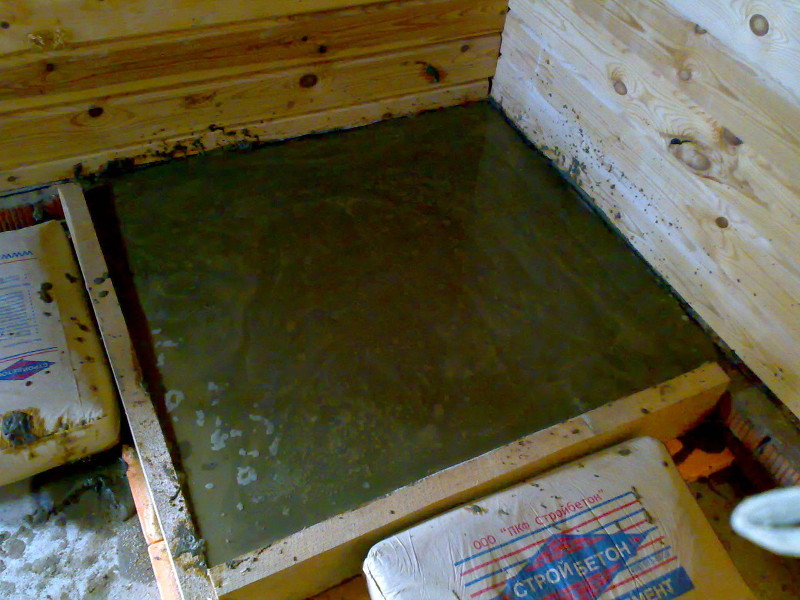
On the finished foundation lays a layer of roofing material for waterproofing. A steel sheet is placed on top, which should protrude 40 cm in front of the front side.
Wall masonry
Furnace cladding is done in a quarter (on edge) or in half a brick. A large thickness reduces the efficiency of the furnace - it will overheat, there will be a fast draft, and most of the heat will go through the pipe. In this case, the brick itself will not warm up enough and heat the room worse.

Work begins with laying the first row with solid flooring. The second row can also be made solid. Next steps:
- In the third row, two 60 mm vents are left in the side walls;
- Before laying the fourth row, a stove is installed, the door is brought to the plane of the wall, the door frame is wrapped in asbestos;
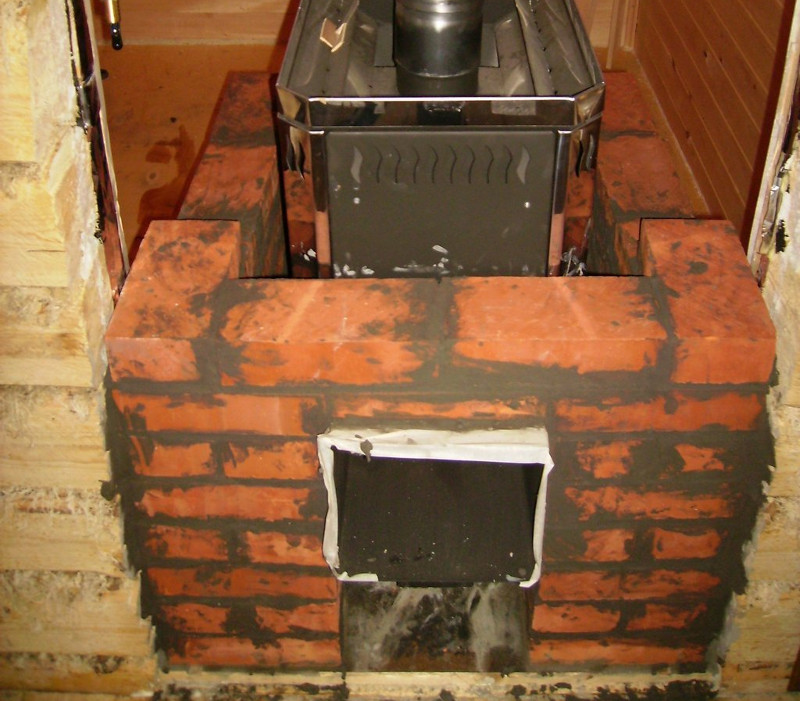
Asbestos is laid around the furnace door
- Three more rows are laid out along the perimeters with continuous masonry;
- Corner No. 40 350 mm long is laid on the top of the sixth row above the door;

- Seventh, eighth and ninth rows - solid masonry around the perimeter;
- In the tenth row, we again leave two vents each;
- The eleventh row is the final one.
 budivel.ru About the insulation and heating of the house.
budivel.ru About the insulation and heating of the house.

